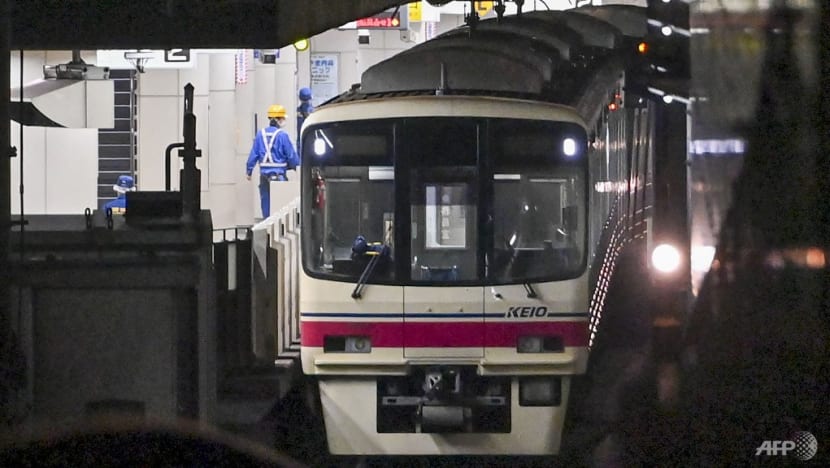Commentary: Tokyo subway attack reveals dangers in how trains are managed
The incident invoked fear not of the lone madman, but of an institutional failure to be flexible in emergency situations, says the Financial Times’ Leo Lewis.

TOKYO: Four days after a knife-wielding man dressed as the comic supervillain Joker unleashed havoc on a Tokyo train, Japanese daytime TV began speculating about how much he paid for the purple suit and green shirt.
One channel, citing police sources, put the outlay at about US$2,000 as it probed the pre-tragedy spending patterns of the homicidal 24-year-old.
The analysis had the feel of a nation resorting to nervous self-distraction rather than settling on what it might legitimately be more worried about.
Japanese corporate culture, with its tendency to reward compliance over elasticity, may yet emerge as the unexpected spectre of the incident.
The most obvious threat was Kyota Hattori, the man who attacked passengers aboard the Keio Line with a knife, splashed lighter fuel around the carriage and set it ablaze.
Seventeen people were injured, one critically. Mobile phone footage showed people fleeing through the train and the sinisterly-attired Hattori sitting down and smoking ahead of his arrest.
These outrages are, in Tokyo and Japan generally, mercifully rare. They tend to prompt the same unanswerable questions: How many more Hattoris might be lurking within Greater Tokyo’s 37.5 million population, undetected, but poised to unleash violence on its peaceful majority?
INSTITUTIONAL FAILURE TO RECOGNISE NEED FOR FLEXIBILITY
Behind the question is an acknowledgment that Tokyo’s supremely successful concentration of humanity functions on trust. In fact, on a series of overlapping trusts: In people, institutions, companies, rules – and in both self, and public, interest.
This is powerfully exemplified in the city’s rail and underground network – a clean, punctual service to which the economy entrusts its workers, civil society entrusts its mobility and parents cheerfully entrust children as young as five travelling alone.
If this transport system is disrupted by fear, Tokyo becomes a gridlocked dystopia.
However, the videos of the attack captured another horror, not involving Hattori but the rail staff. Passengers running through the carriages to escape the attacker and the flames found the doors closed, even though the train had stopped at a platform.
The driver and guard did not know why passengers had activated the emergency stop and could not ask them over the intercom as the occupants had fled.
The staff opted not to open the train doors after the emergency stop as they were not perfectly aligned with the platform doors that now feature at an increasing number of Tokyo stations, designed to prevent both suicides and people accidentally falling on to the rails.
The footage captures the Sunday evening passengers escaping through the train’s high, narrow side windows. That could not have happened if the train were more crowded; Primary school-age children might never have made it.
And with that, the horror of the incident morphed into something both different and creepily familiar. The fear was not only of the lone madman, but of an institutional failure to recognise the need for flexibility: Not just in an emergency but in any situation where an expedient solution falls outside the organisational rules or custom.
PLATFORM DOORS, A DOUBLE-EDGED SWORD?
The fear is real because Tokyoites working for companies instinctively know that there is a problem with the suppression of individuals’ initiative within corporations and institutions.
The transport ministry’s swift decision to hold an urgent meeting of rail companies suggests it had anticipated a backlash.
Without much debate, the ministry ordered rail companies to agree to open the train doors in an emergency, even if they were not quite aligned with the platform. The edict came with an implicit governmental sigh that such orders were necessary.
But there was an additional chill in those images as the platform doors – installed at huge cost and presented as guarantors of safety – instantly became a mechanism of entrapment.
JR East, which is one of 11 main rail companies serving greater Tokyo, is part way through a US$5 billion programme to install these everywhere by 2032.
Other networks also have ambitious plans. They point to the accidents that have been prevented by the platform doors, though as yet have only partial figures to back up the claims.
The footage from last Sunday has flipped the image of something once considered unambiguously good, and has many residents taking to social media to ask whether the rail companies had given full consideration to all possible consequences of installing the platform doors.
Tokyo went back to work, school and normal life the day after the attack. But it did so with new toxins coursing through its lifeblood of trust.
If at least a tiny amount of new workplace flexibility is gained as a result of the attack, perhaps something good will come of it.
















